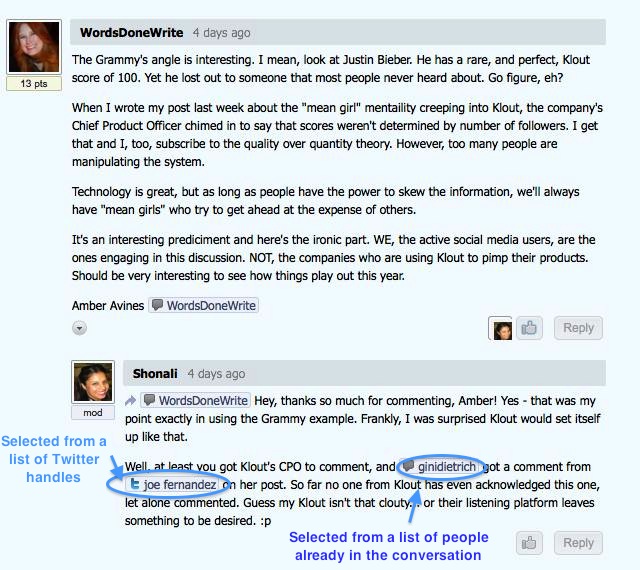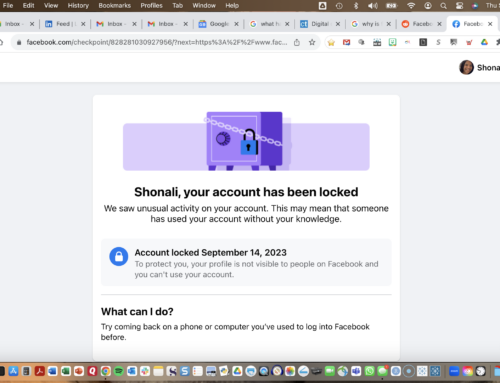 This is part of the Blogging for Grasshoppers series
This is part of the Blogging for Grasshoppers series
If you publish a blog, there are three things I want to tell you today.
I’ll give you the short version, and then the long version.
Short version
1. I think Livefyre, the comment system that has been implemented on WUL for just under two months, is da bomb.
Image: elventear via Flickr, CC 2.0
2. I think you should go grab it.
3. Livefyre has some big news coming out soon… but you’re going to have to read through to see what that is.
If #s 1 and 2 are enough for you, head on over to Livefyre and see how cool it is (or just scroll through some of the posts here, to see it in action).
If not, here’s the long version
I’m not one to get overly excited by blog comment systems, but this one has me blown away.
In a nutshell, what Livefyre does is integrate the two social networks most of us use (and when I say “us,” I mean people like you and me, who are online quite a bit) into its platform.
This allows us to invite folks not already in the conversation, to the table.
What makes Livefyre better
in my opinion, than other comment systems that allow you to post your comments to, say, Facebook or Twitter?
It’s the fact that you can do this while you’re commenting, and not after the fact.
So, for example, if I’m commenting over at Gini’s place, or Joe Hackman’s place, and I think of someone with whom I had a similar conversation, or who would be interested in participating in this one, I simply type an @ into my comment.
Assuming I’m signed in via Twitter (or Facebook, or both), Livefyre then pulls up a list of handles, and I simply select the one that I want to bring in.
Like this (except that Joe Fernandez didn’t bite, in this case):
Livefyre asks me I want to to let them know that I mentioned them in the conversation.
If I decline, nothing happens.
But if I accept, then Livefyre sends them a notification that appears in their stream, in that platform.
I don’t have to do anything else.
And since blog comments are often where the conversation’s at, this is the simplest and, I believe, most effective way of extending and enriching that conversation.
It’s genius. Just genius.
 And it’s so simple! I can’t believe no one thought of it before.
And it’s so simple! I can’t believe no one thought of it before.
But I guess that’s what makes Jordan Kretchmer – founder of Livefyre – special.
(Thanks, Jordan, for letting me use your mug shot).
In Jordan’s words, “We are creating a community of commenters and content producers, connected through conversation and interests.”
Here’s what else I’ve noticed since implementing Livefyre, and why I love it so… in fact, I’ll try to count the ways:
1. Their customer service is great.
Initially, I had some trouble with the Livefyre plugin. I immediately got on the horn with Jeremy Hicks, and it was resolved very quickly.
Then it turned out that the Livefyre plugin was causing some problems with the WordPress Editorial Calendar plugin which I also use and love.
Zack Grossbart, the WPEC plugin creator figured that out, and I put him in touch with Jeremy to talk geek speak.
Voilà . Problem resolved.
2. They truly believe in community.
Jeremy, Jenna Langer and other Livefyre staffers take the time to comment on blogs using the Livefyre system, and you can tell from their comments that they genuinely enjoy doing that.
They understand that in order to build a community, you have to be a part of that community.
3. Engagement really does increase.

“In most cases, Livefyre at least doubles the amount of comments people get, and on a lot of those sites the increase in total engagement is four times what it was before Livefyre.
“Most of our bloggers see big increases in total pageviews, time on page, and overall visits within four weeks of Livefyre being installed.”
Over and above this, I’ve found that as I’ve commented on other blogs using Livefyre, I’ve met folks I might not otherwise have met, and we are slowly becoming part of each others’ communities.
4. Spam is significantly down.
As you might know, I publish regularly in three places including WUL, and have back end access to one of the other blogs, which currently uses Disqus.
Yes, they both use Akismet, and I have another spam-blocking plugin on WUL which did help somewhat.
But ever since installing Livefyre, the difference in spam is amazing.
Hardly any on WUL. The other one – it drives me nuts.
I asked Jordan about this, and he confirmed that it wasn’t just me imagining stuff, that this is something they actively work on. But the details (which were shared with me) are a bit hush-hush right now, so I can’t tell you much about it.
Except that it works.
5. No captcha.
I hate captchas.
I know they’re used to try to keep spammers out, but I’ve had far too many experiences where a captcha didn’t work properly, and a comment I’d put much thought into was gobbled up and spit into a black hole of orphan comments.
Or the captcha was so illegible, that I’d have to put it in over and over again.
As a non-bot, this is extremely frustrating!
With Livefyre, there’s no need for captchas.
W00t!
Livefyre is really remarkable.
I strongly suggest you check it out, particularly if you publish a WordPress blog.
And they’ve got a lot of cool stuff coming down the pike, which leads me to the big news.
Drum roll, please!
And as of today [update at 8:16 am EST] Sunday, March 6, Livefyre is will be open to the public.
This means that you don’t have to sign up for a beta invite, but should be able to grab it immediately on Sunday for your WordPress blog.
[I received this update from Livefyre late last night, at which point this post was already scheduled, so wanted to let you know as soon as I could.]
How cool is that?!
And if you’ve already been using Livefyre on your WordPress blog, you’ll notice a few changes:
There’ll be a new comment design, with multiple nesting levels
The file plugin will be 85% smaller, which means it will move much faster
You’ll have a new administrator/moderator panel, which will give you a lot more options to moderate the conversations with.
Livefyre also has plans to shortly (most likely by the end of March) introduce integration with Drupal, Typepad and Blogger (it already supports WordPress, Joomla and open web install).
In addition, it will introduce a CommentLuv-style feature, should the blogger decide to turn it on, that will allow commenters’ most recent posts to appear at the end of their posts.
You know that I wouldn’t urge you to use something if I didn’t find it useful.
And with Livefyre, I don’t just find it useful, I find it highly enjoyable as well.
So do please check it out.
And let me know what you think!









[…] they created my app for me, and then worked out a few bugs very quickly (I swear, these guys might rival Livefyre for their customer service), I asked if I could share it with you. At which point Josh gave me the green […]
Try this site, it may help you. Goodluck! http://masozlerimstanbul.com/
ow ! it is a nice information related website. I already bookmark this website & visit regularly.
I have also a website.you can also find something new information from my site http://www.articlesface.com
[…] it works, check out this epic comment battle going on at Days of Yorr right now! Also, check out this great blog post about how to get the most out of […]
[…] Comment on WUL, and ask questions not just of me, but of others as well, even if they’re not already on the blog; that’s why I use Livefyre as my comment system […]
This is my first time i visit here. I found so many interesting stuff in your blog especially its discussion. From the tons of comments on your articles, I guess I am not the only one having all the enjoyment here! keep up the good work.
24/7 NEWS ….24/7 NEWS
Live News, India News Free, CA News, News Online,
<a href=”http://avilableallnewshere.blogspot.com/”>24/7News</a>
<a href=”http://www.sportsevents365.com/?a_aid=4fac22f90aa0e/”>Online Tickets</a>
RPG Flash Games
RPG Flash Games
RPG Flash Games
Your article is superbly awesome. I’m so satisfied with the information. I was always confused about how to choose best deals, Thank you so much, please keep writing such articles. Deals Of the day
Your article is superbly awesome. I’m so satisfied with the information. I was always confused about how to choose best deals, Thank you so much, please keep writing such articles. Deals Of the day
I’ve been using disqus before but now i switched and i’m glad i did.
When we announced our private beta, we were overwhelmed by the number of people who wanted to give Livefyre a go on their sites.
I’ve had far too many experiences where a captcha didn’t work properly, and a comment I’d put much thought into was gobbled up and spit into a black hole of orphan comments.
@Shonali@cabinets Orlando Thanks for the thoughts and feedback. At the moment that’s not possible, but as you know, we’re always open to feedback and will keep that in mind as we continue to push updates to the product!
@cabinets Orlando I hit the “stop following conversation” too, for other blog conversations. No offense to anyone else, but those constant notifications drive me nuts. If someone brings me back into the conversation, I get that notification anyway.
Hmm, I wonder… @JMattHicks , is there a way to post one’s initial comment AND *not* follow the conversation at the same time? That might cut down on the angst some of us feel.
@Shonali
<a href=”http://avilableallnewshere.blogspot.com/”>24/7News</a>
I know it can be overwhelming. If they’re notifications for my blog, I prefer they come in as the comments, etc., show up. If they’re for conversations on other blogs, I sometimes hit the “stop following conversation” option, and if it’s a post I really like, I’ll just go back there in a day or two.
[…] Months after Danny Brown trialed the system and touted why he loved Livefyre, everyone from Gini Dietrich to Patrick Phillips and Shonali Burke pointed out positive impacts on metrics, conversion, and usage. […]
Yes i totally agree with you that livefyre is a best option for commenting… but how it is different from disqus…
@Shonali @sives Let us know if you have any questions, @JMattHicks and I are happy to help! :)
@Shonali @sives Let us know if you have any questions, @JMattHicks and I are happy to help! :)
@sives Let us know if you try it! cc @JMattHicks @jennalanger
Been reading about it, sounds very good
@mohdismail Heh, you’re a convert too, are you? Awesome!
oh yes it is ;)
[…] set up Livefyre as the comment system (‘cos it’s AWESOME and has cut down spam to such an extent on WUL that I don’t […]
[…] conversation is what matters. I can see why people like the Livefyre and Disqus comment systems. The ease of login, reply subscriptions, the real-time updates that […]
@Shonali @richie.escovedo @JMattHicks Hey Richie! I’m really excited about how Livefyre can be used in education. Feel free to email me at jenna at livefyre dot com if you have any questions. Thanks!
@richie.escovedo Totally my pleasure! Definitely talk to @JMattHicks or @jennalanger if you have more questions. They rock.
Thanks for sharing, Shonali. This is great information. Blog commenting systems just happens to be something I’m investigating for our school district’s blog..
I am totally with you on the “increases comments.” I subscribe to comments, but don’t always go back and mix it up in the conversation. This system encourages you to do so b/c you reply to everyone in the comment thread, not just the one commenter or original poster. IDK.. I just get more out of it sometimes than other comment reply notifications. The other feature, which Disqus also has, is the simple LIKE button. If I don’t have anything else to add to a discussion, I can still let others know I saw, read and appreciated their comment or feedback with an easy click. Keeps the discussion going.
On the downside, I wish there were more efficient streamlined ways to set those notifications as my inbox is sometimes overwhelmed by Lifefyre updates (I comment too much). Another thing I love, which I don’t see via this system, are CommentLuv type blog links. As I read comments I’m often grabbed by the headlines of everyone’s recent post, like meeting new bloggers that way. Plus it’s a nice gift to those who take the time to comment.. a little link love of their own blogs.
I am considering upgrading my blog comment system and Livefyre is certainly in the running. FWIW.
Livefyre is the future of blog commenting. And they care about usability. I cannot imagine using another comment system. And when I added the plugin to my blog and had somne issues to start, jennalanger was always quick to respond and help me out. Seriously, if you try it, you will never go back :).
@JGoldsborough Thanks a ton Justin, it’s been really helpful getting feedback from our community – just wait until you see all the new stuff in a few days! And thank you @Shonali it’s been great being partt of YOUR community! :)
@jennalanger Absolutely my pleasure. What is really cool about Livefyre is how stoked everyone who uses it gets – like @JGoldsborough , me, et al. I can’t wait until you guys throw the doors open and everyone gets to use it!